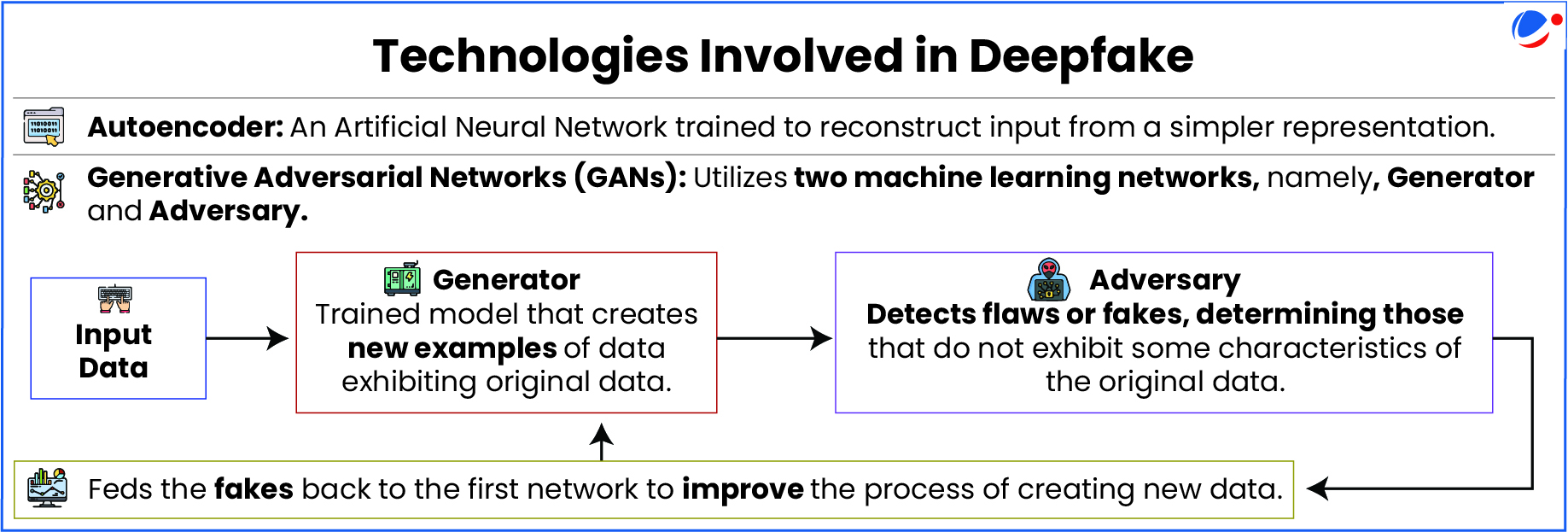Why in the News?
Recently, the US enacted Take It Down Act" to tackle harmful deepfakes online.
What are Deepfakes?
- About: Deepfake is a video, photo, or audio recording that seems real but has been manipulated with AI blurring the line between reality and manipulation.
- Technology: deep learning techniques are used for making such videos
- Deep learning represents a subset of machine learning which are themselves a subset of artificial intelligence.
- It involves replacing faces, manipulating facial expressions, synthesising speech, appearing to say or do things not actually done.
- Potential Applications:
- Entertainment (creative effect in movies);
- E-commerce (creating customers likenesses for virtual trial of clothes);
- Communication (Speech synthesis for speaking in another language), etc.
- Regulation:
- India: India lacks specific laws for deepfakes and AI-related crimes, but provisions under some existing legislations offers both civil and criminal relief.
- Global:
- EU's Artificial Intelligence Act (AI Act), is designed to foster trustworthy AI.
- Italy: Both the Italian Constitution and the Civil Code prohibits the unauthorised use of a person's likeness.
- 23 states of USA have passed legislation addressing deepfakes (as of September, 2024). Similar legislations in other countries are:

Concerns associated with Deepfakes
- National Security Risk: Fake videos may spark violence, disrupt investigations, or create false alibis.
- Erodes Trust in Democracy: Fake political content can mislead the public and harm democratic processes.
- Victimising Women: Approximately 90-95% of deepfake videos since 2018 were primarily based on non-consensual pornography.
- Cyberbullying: Rumours can spread faster when coupled with fake images or videos impacting a person's reputation.
- Identity Theft: Creating fake identification documents, causing cybercriminals to impersonate individuals or gain access to secure systems.
- Lack of Awareness: Even when a deepfake video is detected it would be ineffective in containing misinformation due to lack of awareness among people.
- Costly Computation: Huge investment is needed to tackle vast datasets and employ advanced computation resources, especially for detecting videos vis-à-vis images.
Initiatives that tackle Deepfakes in IndiaLegal Framework
Institutional
|
Way Forward on dealing with the issues of Deepfakes
- Enhanced Regulation: Create a well-defined legal framework based on real-world harms caused by AI. Focus on proactive action, not just post-incident responses. Current Indian IT Rules only act after harm is done. Victims bear the burden of filing complaints—this needs reform.
- Build Strong Institutions: Set up agencies with clear safety standards to protect people and reduce misuse.
- Technological Advancements: Sophisticated algorithms, including new methods that can identify deepfakes based on their context, metadata or other factors.
- E.g., Massachusetts Institute of Technology (MIT) created a Detect Fakes website to help people identify deepfakes by focusing on small intricate details.
- Cyber Literacy: Promote media literacy and critical thinking incorporating digital trust to protect all stakeholders' interests and uphold societal expectations and values.
- Stakeholders' Collaboration: Introduce clear procedural guidelines and effective penalties by incorporating suggestions from all stakeholders, like law enforcement, judicial authorities, etc.



